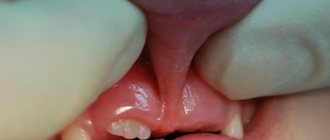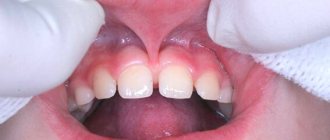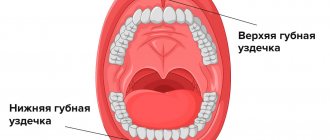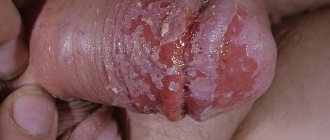Tongue frenulum cutting - what is it?
Plastic surgery of the lingual frenulum can be performed at different ages, but it is mainly performed on newborn children, since disruption of the formation of the mucosal fold under the tongue causes a number of functional disorders.
The procedure for trimming the frenulum of the tongue is a low-traumatic surgical procedure performed by a dentist. The frenulum of the tongue is a fold of the oral mucosa that stretches in the shape of an arc from the central point of the tongue to the middle of the lower dentition at the base of the gums. The main function of the frenulum is to attach the tongue to the lower part of the mouth.
If there are deviations in the location or length of the fold, the movement of the tongue will be impaired, resulting in incomplete functionality. The purpose of the operation is to increase the length or correct the position of the frenulum.
Short hyoid frenulum
- Speech therapist.No
- Consultations
- Short hyoid frenulum
During the consultation, you were told that the child has a short hyoid frenulum and in the future it will most likely need to be trimmed. What to do?
Hyoid frenulum
The sublingual frenulum is a membrane that is located under the tongue and connects the tongue to the sublingual space.
How to determine whether the hyoid frenulum is long enough?
Indeed, in different people the hyoid ligament (frenulum) can be of different lengths. If a child can stick his tongue out of his mouth and at the same time its tip does not bifurcate in the shape of two semicircular petals due to the fact that the hyoid ligament pulls it from below, if he can lick the saucer and click his tongue, then he will most likely have no obstacles for making sounds that require raising the tongue to the palate.
In a 5-year-old child, the frenulum in a stretched state should be at least 8 mm.
Short hyoid frenulum
A short hyoid ligament (frenulum) is a congenital defect consisting of shortening of the lingual frenulum (hyoid ligament).
What does this mean?
Short hyoid frenulum:
- may cause difficulty in tongue movements, because does not give him the opportunity to rise high. In this case, the so-called “upper sounds” suffer, i.e. the pronunciation of sounds such as Ш, Ж, Ш, ШЧ, Р, Рь is impaired
- can lead to a displacement of the center of the tongue, its asymmetrical development and low mobility, which prevents the formation of the correct articulatory posture of some sounds.
- may also be the cause of a violation of diction (Diction is clarity, intelligibility of pronunciation)
- in some cases, it can provoke problems with the formation of the lower jaw, i.e. The teeth may deviate and the necks of the teeth may become exposed. There is a risk of developing periodontitis and gingivitis. Therefore, a consultation with an orthodontist is necessary.
What to do?
There are two options to solve the problem:
- Stretching the hyoid frenulum
- Surgery
Stretching the hyoid frenulum
- This is reasonable if the frenulum is not very short, otherwise stretching a very short frenulum, according to some doctors, can lead to sagging of the mucous membrane, etc. the problems described above (periodontitis, gingivitis).
- Stretching is most successful up to 5 years of age. And the older the child, the more difficult it is.
- Stretching does not cause as much stress to the child as surgery, but it takes significantly more time and effort. After all, the corresponding exercises need to be performed several times a day, every day, and on a positive wave.
- Stretching with the help of speech therapy massage is an unpleasant process, often very painful for the child.
- Surgery is often easier for some parents.
Even if the frenulum is somewhat shortened (equal to 8 mm), it is better to stretch it than to operate
Many exercises can be started from a very early age. Remember! The baby will not be able to sit with you in front of the mirror and do the exercises according to your instructions. Turn everything into a game.
Exercises for the little ones
1) Lick the saucer. Invite your child to lick the saucer like a kitten.
2) Reach with your tongue for the spoon 3) Reach with your tongue to your chin 4) Reach with your tongue to your nose 5) Swing open your mouth, with the tip of your tongue reach first to the nose, and then to the chin, then again to the nose, and then again to the chin. 6) The horse smile, open his mouth. Click the tip of your tongue like a horse clicking. The mouth is open, the tongue should be wide. Make sure that the tip of the tongue does not turn inward, and that the lower jaw remains motionless. You can sit on a toy horse (if there is one in the house), or you can sit on your mother’s lap.
Exercises for older children
Along with the previous ones, you can do the following exercises:
1) Delicious jam: open your mouth slightly, the tongue moves along the upper lip from top to bottom, but not from side to side (as if licking the jam). The lower jaw should be motionless. 2) The painter invite the child to use his tongue, like a “brush,” to paint the ceiling in the “house” - the mouth. To do this, you need to open your mouth and stroke the palate with the wide tip of your tongue, making movements back and forth (from the teeth deep into the oral cavity and back). 3) Drum Show your child how to imitate a drum by beating a beat with your tongue. To do this, you need to open your mouth, smile slightly and, with the tense tip of your tongue, tap on the alveoli (tubercles behind the upper incisors), repeatedly and clearly, in one breath, pronouncing the sounds “D-D-D.” Tap slowly at first and then increase the tempo. Ask the child to repeat. Make sure that the child does not close his mouth during the exercise. 4) The fungus opens its mouth wide, presses the wide flat of the tongue against the palate and sucks it. Hold your tongue in this position for 5-10 seconds. The tongue will resemble the cap of a fungus, and the stretched hyoid ligament will resemble its thin leg. Then, “unstick” your tongue and close your mouth. Repeat the exercise 2-3 times. 5) Accordion Show your child how to draw an accordion using your tongue. To do this, you need to suck the wide tip of your tongue to the roof of your mouth, as in the “Mushroom” exercise, and then, without peeling off your tongue, open and close your mouth. The hyoid ligament (frenulum) will act as an accordion, which either stretches to its full length, then contracts.
Remember!
- Exercises must be performed systematically, gradually increasing the time they are performed (the number of repetitions of each exercise), only then will the desired effect be achieved.
- The sooner you start classes with your child, the faster you will achieve the desired result.
- The older the child, the more difficult it is to stretch the hyoid frenulum (targeted stretching of the hyoid frenulum using speech therapy massage is an unpleasant procedure, quite painful for the child). Stretching is most successful up to 5 years.
Surgery
Surgery is always stressful for a child
- You need a good doctor and modern equipment. Good reviews about the consequences of operations under local double anesthesia. But this is the doctor's choice.
- If something goes wrong, there is a risk of scar formation, making it difficult for the tongue to move.
- Short period of time for correcting sound pronunciation.
- After cutting, the hyoid ligament can grow back together if you don’t start working on it in time, i.e. no earlier than 10-14 days and no later than 1 month. after operation.
- Sometimes surgery is recommended for medical reasons by an orthodontist, not only because of shortcomings in sound pronunciation. If you do not trim the hyoid frenulum, then SOMETIMES there is a risk of periodontitis, gingivitis (bleeding, exposure of the necks of the teeth), large gaps between the teeth, deterioration of the natural self-cleaning of the oral cavity... But this is not immediately visible, everything is in the distant future... And it happens far from everyone, only a doctor can qualify such a case.
Indications for the procedure
For newborn children, cutting the frenulum of the tongue is recommended quite often. A pediatrician or dentist can identify the pathology. In most cases, disorders are detected already in the first months of a child’s life. At the same time, the doctor always takes into account the individual characteristics of the structure and position of the mucous fold.
If we are talking about a newborn baby, then plastic surgery is prescribed in the case of obvious pathology in the formation of the frenulum, or difficulties with breastfeeding. The baby may have difficulty latching on to the nipple or pacifier and difficulty sucking on the breast or bottle.
Untimely plastic surgery may subsequently lead to difficulties with chewing food, bite formation, and diction problems. In older age, recommendations for surgical treatment can be given by a speech therapist or orthodontist.
Why does a short frenulum of the foreskin develop?
In the vast majority of cases, this defect is congenital, often combined with a pathological condition such as phimosis. The latter is characterized by the narrowness of the foreskin, which does not allow the head of the penis to be exposed.
It is found in 96% of newborn boys, but as their body develops, the foreskin gains the necessary mobility, and the problem goes away on its own. At the age of three, it is found in only 10% of young patients.
The causes of a short frenulum are as follows:
- different rates of development of skin structures and cavernous bodies of the penis;
- inflammatory processes of the structures of the penis, occurring in a chronic form;
- constant injury to the foreskin when playing sports, wearing incorrectly selected underwear and too tight trousers;
- diabetes mellitus, which provokes failures in tissue regeneration.
Contraindications
Tongue frenuloplasty in newborns does not involve major surgical intervention, so the operation is considered safe. In addition, the procedure is painless and does not require anesthesia. However, given that after cutting a short fold of mucosa, a small wound still forms, there are temporary restrictions on manipulation related to the child’s health condition.
Temporary contraindications:
- inflammatory diseases;
- infectious diseases;
- immunodeficiency pathologies;
- acute respiratory viral or bacterial infections.
If there are contraindications for health reasons, it is advisable to postpone the operation until complete recovery.
Upper lip frenulum
Even with a simple smile you can see the frenulum of the upper lip, but few people pay attention to it. During a routine examination, the doctor assesses its length; in order to assess the size of the frenulum at home, parents just need to move the baby’s upper lip, and it will become noticeable where exactly the frenulum is woven. In the event that the frenulum is woven between the two front incisors 5–8 mm higher, this is a normal option. If the frenulum is woven below this level, these are obvious symptoms of a shortened frenulum, but the final word always remains with the doctor.
A short frenulum on the upper lip can provoke a violation of the aesthetics of a smile when a gap is formed between the central incisors - a trema, a diastema. It is worth remembering that tremors can be physiological; this period is observed during the period of primary occlusion, when the child’s jaws are preparing for the change of primary teeth to permanent ones. In addition, trems can be pathological, which are formed as a result of some pathology. Treatment of this problem is most often carried out in tandem by a surgeon and an orthodontist.
A short frenulum in a child’s mouth can cause malocclusion, which is formed due to the constant tension of the mucous membrane on the upper jaw and bone tissue. As a result, the front incisors move forward. In addition, such pressure on the mucous membrane provokes inflammation of the mucous membrane - gingivitis. There is a loss of gums, as a result of which the necks of the teeth are exposed and the child develops hypersensitivity of the teeth, and all the conditions are created for the formation of cervical caries.
How does the correction happen?
Treatment of the problem is exclusively surgical, but with one big “BUT”. The frenulum on the upper lip can be corrected only after the eruption of the permanent central incisors, not earlier!!! In some cases, the doctor will recommend adjusting the oral frenulum at the time of the eruption of the permanent lateral incisors - in order to close the gaps between the teeth, such a correction can eliminate orthodontic treatment.
The reason for this ban is very simple. The fact is that during the growth of the jaws, the frenulum on the upper lip can self-correct. That is why there is no point in correcting the frenulum at an earlier age. The correction itself is carried out in a surgical room, under local anesthesia. There are no nerve endings in the mucous cord itself, and therefore the operation is painless; pain relief is necessary when suturing. The operation lasts no more than half an hour and ends with stitches. Thanks to the use of a laser, there is no need for stitches. But there is a certain condition that must be observed after excision of the frenulum: the little one must immediately be attached to the chest.
Features of the procedure
Plastic surgery of the frenulum of the tongue involves cutting it with a scalpel or surgical scissors. After cutting the fold of the mucous membrane in a newborn, the tissue immediately stretches and lengthens after healing. When the operation is performed at the age of 3–5 years, the process of stretching the frenulum is more complex. To increase the length of the fold and prevent the formation of scars, the child will need to perform special exercises.
In Martinka dentistry, plastic surgery of the frenulum of the tongue and lip is performed not only by the classical, but also by the modern method using a laser. The use of laser equipment eliminates the risk of infection and bleeding. The laser has an antiseptic effect and instantly seals the vessels; moreover, during the operation there is no contact of the instrument with the tissues of the oral cavity. Laser surgery involves contraindications and is only allowed for children over 1 year of age.
For newborn children, tongue frenuloplasty can be performed without anesthesia. In children from 3 months of age, the folds of the mucous membrane thicken, which suggests discomfort and minor pain during the operation, so cutting the frenulum is done with local anesthesia. Sedation is used only in extreme cases, if the child has complex illnesses or increased anxiety.
Features of the anatomical structure of the foreskin
The foreskin is represented by folds of skin, which are one of the elements of the protective cover covering the male penis.
One of the folds is located along the body of the latter and connects the foreskin and the head of the penis to each other. It's called a bridle. The features of this anatomical formation are such that it can stretch when the flesh moves, or during sexual intercourse, when friction is performed. In the latter case, if the frenulum is of sufficient length, the head receives additional stimulation due to slight bending. If it is too short or the skin folds do not have the desired elasticity, complete exposure of the head of the penis during erection becomes impossible, so this defect can only be identified during the boy’s puberty. Treatment of a short frenulum of the foreskin is simply necessary, since this defect is characterized by a number of extremely unpleasant manifestations for any man. The penis becomes cosmetically defective, appearing curved during erection. During sexual intercourse, a man feels pain, and the frenulum, due to excessive tension, can tear and even rupture. Due to scarring of wounds, the defect intensifies, causing disruption of erectile function, emotional distress, and even fear of sexual relations.
Stages of the procedure
Trimming a short frenulum, despite the lack of complexity of the procedure, should be performed by a qualified specialist and in a medical facility. Patients do not require hospitalization. The operation takes no more than 10 minutes. Immediately after completion of the plastic surgery, the child is sent home. It is not recommended to feed the baby in the first two hours. Young children are allowed to drink water.
Stages of plastic surgery of the frenulum of the tongue.
- Preparation. The doctor asks parents for complaints, performs an examination and, if necessary, gives recommendations on preparation for the procedure.
- Operation. Administration of anesthesia, antiseptic treatment of the oral cavity, trimming of the frenulum.
In newborns, the integrity of the mucous membrane is restored in 1–3 days. The child may be restless on the first day. Difficulties with feeding cannot be ruled out, but already on the second day, babies begin to correctly take the breast or bottle nipple, which caused difficulties previously. Parents are advised to give the baby water after each feeding to avoid the accumulation of formula or milk in the mouth and the subsequent development of infection. Also, the mother must maintain breast hygiene and sterilize bottles.
Frenules in the oral cavity
When parents talk about the frenulum in the child’s mouth, most often they mean the frenulum of the baby’s tongue, which is quite natural. Problems arise more often precisely because of this oral frenulum: from improper attachment to the breast in the first days of life to speech impairment in the future.
Even dentists give the leading role and importance to this particular frenulum, but this does not mean that the remaining frenulums are unimportant and cannot provoke any pathology.
There are three frenulums in the child's mouth. A frenulum in the oral cavity is nothing more than a small strand of mucous membrane. But, despite this, the frenulum in the oral cavity is of great importance in the life of a child; the child’s nutrition, correct pronunciation of sounds, the condition of the mucous membranes, not to mention the child’s bite and facial aesthetics depend on their condition.
Dentists distinguish between the frenulum of the upper and lower lips and the frenulum of the tongue. Each of them has its own location and performs a number of functions. The frenulum of the lower lip connects the body of the lower jaw and the lower lip; normally, the frenulum is woven into the gum of the lower jaw below the level of the central incisors.
The frenulum of the upper jaw is located according to the same principle as the frenulum on the lower lip. This mucous cord also raises many questions and complaints from parents, since it is primarily associated with the formation of an aesthetic defect in the oral cavity - a gap between the teeth. And the last frenulum in the baby’s mouth is the lingual frenulum, which is woven into the tongue and sublingual space.
results
The main goal of tongue frenuloplasty is to prevent tongue dysfunction that occurs subsequently. If you do not trim the folds of mucous membrane, then in the future the child may have difficulties with eating, diction and lip movements.
Don't be afraid of surgery. This is a simple procedure that takes a few minutes, and the cutting of the short frenulum itself takes place in a few seconds. Since the mucous membrane in children is still too thin, the child does not feel pain. Minor bleeding goes away quickly and does not pose any danger.
The help of a qualified dentist is an absolute guarantee of high-quality results and the absence of complications.
Frenum of the lower lip
Dentists say that not all babies have a frenulum on the lower lip; it may be completely absent or forked. To study the length of the frenulum, the same technique is used as for studying the frenulum of the upper lip. Normally, the frenulum should be thin and attached in the middle of the body of the jaw. An important condition is that the frenulum of the lower lip must coincide with the center line between the incisors. If these conditions are not met, the bridle is short.
A short oral frenulum interferes with breastfeeding, as the baby cannot properly latch onto the mother's nipple. Fortunately, this situation is quite rare; the most typical manifestation of a short frenulum in the oral cavity is the presence of inflammatory gum diseases in the area of the lower incisors and malocclusion according to the same principle as in the upper jaw.
There are no age restrictions when excision of the mandibular frenulum; usually the mandibular frenulum is diagnosed and corrected at approximately the same time. The principle of the operation is similar to correction on the upper jaw.










